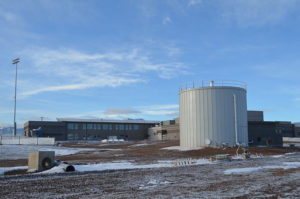Chlorine levels far below state minimum; blame it on the tank
by Mark Craddock
 LA VETA — In January 2023, less than a year after a ribbon-cutting ceremony heralded the opening of the new La Veta School, students and staff started to notice something amiss with the water. Many complained it just smelled and tasted bad.
LA VETA — In January 2023, less than a year after a ribbon-cutting ceremony heralded the opening of the new La Veta School, students and staff started to notice something amiss with the water. Many complained it just smelled and tasted bad.
Subsequent tests revealed that the water in the building was far below the state standards for chlorine.
Tests conducted in January and February showed that water flowing from the school’s 200,000-gallon water tank into the school’s sinks, toilets, drinking fountains and showers was consistently testing far below the state-minimum of 0.2 parts per million (ppm).
However, town-supplied water flowing into the tank far exceeded state minimums.
Superintendent Bree Jones sent a March 9 message to school staff, students and parents explaining the problem and outlining steps to remedy it.
“In order to bring the chlorine levels in the water up to standard, the short term solution has been/is to flush and fill the tank, which we are repeatedly doing, usually on Fridays,” Jones’ message reads.
But that short-term fix brings with it extreme water waste.
“This solution is counter-productive and expensive,” Jones wrote. “The longer term solution being proposed by district building and engineering teams is to make a direct connection from the water line that serves the inflow valve on the tank to the building, which will benefit all by ensuring that we deliver water to our students in accordance with state law and regulations and that we properly conserve water through its efficient use.”
She said the school district is in talks with the town of La Veta now, to map out subsequent steps.
How we got here
Back in 2000, the La Veta RE-2 school district annexed a roughly 34-acre parcel of land into the town, upon which was built the school’s sports complex. At that time, the district’s water needs to maintain a football field at the site were minimal and dreams of a new school at the site were years away.
So in the original annexation agreement, the town sought language saying the district must petition for an amended annexation agreement if it were to further develop the site.
In 2019, the school district received a roughly $42-million state BEST grant to build a new school.
What followed was some two years of fraught negotiation over the amended annexation agreement. Even as planning and construction of the school commenced, the La Veta Town Board and the school board seemed to talk over, under and around each other for months on end.
One of the chief issues of contention was some $975,000 in tap fees the town was charging to provide water and sewer service to the site.
In August of 2020, the school board voted to go its own way, petitioning the town for de-annexation and moving forward with plans to set up its own water system, utilizing well water.
The school board sunk test wells at the site, purchased augmentation water rights and installed a 200,000 gallon water storage tank, to feed the school’s needs.
The town refused to consider the de-annexation petition and in 2021 sued the school district for breach of contract regarding the original 2000 deal.
The two sides entered binding mediation and, in April of 2021, emerged with a mediated settlement which would become, in essence, the amended annexation agreement.
The agreement called for the school district to abandon its well-water plans and buy town water and sewer taps, at a lower rate than originally charged. To make up the difference, the district transferred its water rights to the town and deeded to the town Lot 60 – a parcel of land adjacent to the old La Veta school that in the distant past had been a football field.
But the school district kept its water tank. The agreement called for the town to connect its water supply directly to the tank, which would then supply the school.
Throughout the 2021 negotiations La Veta Mayor Doug Brgoch, who at the time was also a state Division of Water Resources senior water commissioner, cautioned that storing water for long periods in the tank could precipitate water-quality issues – especially with the chlorine levels.
The town insisted on language in the mediated agreement that the town is responsible for water quality from the main line into the meter, and the school district is responsible for water quality of water released from the storage tank and beyond.
Less than a year after the new school opened, Brgoch’s warning and the agreement’s language seem prophetic.
‘Water not tasting right’
According to a March 2 letter from Brgoch to the school board, La Veta’s water treatment operator Shannon Shrout was asked by school staff to test the water coming out of the school’s tank.
“At the time of sampling, Mr. Shrout was informed by the school’s maintenance supervisor that the school did not have the proper equipment or training to undertake the necessary chlorine tests themselves,” the letter reads. “As such, no chlorine sampling had been performed up to this time.”
Between Jan. 17 and Feb. 21, Shrout conducted chlorine tests six times.
“Results of the individual chlorination tests performed, showed there was very little chlorine in the water coming out of the water storage tank and therefore in the School-owned and maintained lines,” Brgoch wrote. “This information was provided by Mr. Shrout, in text form, to the School Maintenance Supervisor, Mr. Zanolini, and to the School District Superintendent, Ms. Jones, starting on January 17, 2023 and continuing through February 14, 2023. Mr. Shrout expressed the need for the School to undertake immediate action to resolve the problem given the tack of chlorine in the School’s water.”
The test results were:
Date Chlorine Chlorine
of test out of tank from town
(ppm) supply (ppm)
Jan. 17 0.04 0.84
Jan. 24 0.02 1.10
Jan. 31 0.41 1.55
Feb. 7 0.04 1.45
Feb. 14 0.06 1.45
Feb. 21 0.06 1.41
(The Jan. 31 test was the only one in which the school’s water exceeded state minimum of 0.20 ppm. Shrout noted “air in line,” perhaps indicating the tank had been recently flushed.)
“Once we became aware of the issue, we ordered our own chlorination testing equipment to monitor the issue,” Jones wrote, “as we understand that this is not the responsibility of Mr. Shrout or the Town of La Veta.”
In an e-mail exchange with La Veta Town Clerk Heather Hillis last week, Jones discussed the fix recommended by the school’s engineers – a two-inch line from the town supply directly to the school’s water system, circumventing the tank. The existing two-inch line into the tank would remain, to keep the tank full for fire-suppression needs, but the tank would not be connected to the school’s main water supply.
In response, Hillis wrote, “After more research on my part… no board action is necessary at this time. The Town would like to have your engineer contact our engineer to discuss the line size to make sure it is sufficient to supply the water to the school. Secondly, an amendment will be required to the annexation agreement to the part two of treated water to include the new ‘two-pronged’ system. We can talk next week.”
A spokesperson from the Colorado Department of Public Health and Environment (CDPHE) confirmed last week that the agency is aware of the problerm and has encouraged the district to do further testing and implement mitigataion measures, which the district is already doing.
“Per federal regulations, the school does not meet the definition of a regulated public water system because it is receiving water from a regulated public water system (the Town of La Veta) and is not treating or reselling the water,” CDPHE spokesperson Gabrielle Johnston said. “It is not uncommon for similar facilities to have on-site water storage. Federal or state law does not require the school to have any water system permits or to conduct any water quality reporting, because they are storing water from an already regulated water provider and not treating or reselling that water.
“Federal regulations require all public water systems to maintain a disinfection residual of at least 0.2 ppm throughout their distribution system. The Town of La Veta is currently meeting the chlorine residual standards.”




